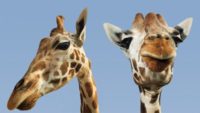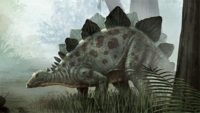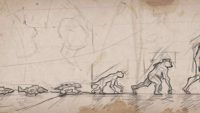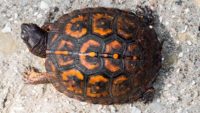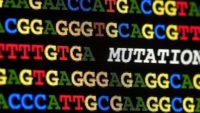By Ken Ham Antibiotic resistance in bacteria is one of the biggest problems facing modern medicine, and it’s also often lauded as evidence for evolution. Bacteria have the ability to survive when introduced to an antibiotic that would normally kill them. Recently a popular video claimed that scientists were able to watch evolution happen in just 11 days as bacteria “evolved” resistance. But did they really see molecules-to-man evolution in action? Well, we’ve written about antibiotic resistance many times, and this new study offers no new support for evolution. Evolution involves the addition of brand-new genetic information to create novel [More]
Discoveries of such things as gene regulatory networks and epigenetics are creating a crisis for evolutionists …read more Read more here: creation.com
By Ken Ham Up until very recently, all giraffes were considered one species with up to nine subspecies. But new research in genetics claims there are four distinct species of giraffe—the southern giraffe, northern giraffe, reticulated giraffe, and Masai giraffe. Apparently these new species are genetically “as distinct as brown bears are from polar bears.” These four giraffe species and the okapi are all members of the giraffe kind that God originally created. God designed each kind with a massive amount of genetic variability in their DNA. This incredible variety allows them to spread out and fill different environments all [More]
By Ken Ham As scientists study God’s creation, they never cease to be surprised by what they find. The newest surprise comes from a well-preserved fossil of a Labrador-sized dinosaur, the Psittacosaurus. Detailed examination of this fossil reveals that this dinosaur “dressed in camouflage.” This dinosaur was buried with skin and even pigments intact. This means it had to be buried extremely rapidly before it had a chance to decay. Of course, the conditions of the global Flood of Noah’s day were perfect for rapidly burying organisms. As the floodwaters washed over the continents, miles of sediment were ripped up [More]
One of Australia’s iconic animals has a big bite but is not as fearsome as it’s made out to be. …read more Read more here: creation.com
By Dr. Andrew Fabich Evolutionists frequently cite the genetic code’s universality as proof of evolution from a common ancestor. …read more Read more here: AIG Daily
By Troy Lacey Researchers made the claim that evolution of the placental mammals sped up faster in the 10 million years following the extinction of the dinosaurs. …read more Read more here: AIG Daily
Data storage technology has come a long way since punch cards. But the undisputed king of data density is still DNA. A team of scientists fit 70 billion copies of their genetics book—including page formatting instructions and images totaling 700 terabytes of data—into just one gram of DNA. Read More: Scientists Store 70 Billion Books on DNA | The Institute for Creation Research
Exciting research from the summer of 2012 described DNA variation in the protein coding regions of the human genome linked to population growth. One of the investigation’s conclusions was that the human genome began to rapidly diversify not more than 5,000 years ago.1,2 This observation closely agrees with a biblical timeline of post-flood human diversification. Yet another study, this one published in the journal Nature, accessed even more extensive data and unintentionally confirmed the recent human history described in Genesis.3 Read More: Genetics Research Confirms Biblical Timeline | The Institute for Creation Research
Perhaps the greatest problem for evolution is where and how the first biomolecules and cells originated by means of random processes. And if that problem wasn’t substantial enough—essentially statistically and biologically impossible—a new discovery makes the odds even worse. Colonies of complex fossil microbes have recently been found that allegedly push the origin of life to at least 3.7 billion years into the past—a period of time thought to be unfavorable for life to begin. More… …read more Read more here: icr.org
By Dr. Gordon Wilson You don’t have to travel to Paris to see one of the world’s greatest cathedrals. If you look carefully, one may be walking around in your own backyard. …read more Read more here: AIG Daily
By Melinda Christian Scientists are learning more and more about the marvelous abilities of animals, which go far beyond physical design. …read more Read more here: AIG Daily
By Dr. Joe Francis To keep us safe, our body coordinates with a vast network of foreign agents that have joined our side. …read more Read more here: AIG Daily
By Dr. Georgia Purdom Truth or science fiction? It’s possible to bypass your ears and send electrical signals directly to the brain. True. …read more Read more here: AIG Daily
Should creationists expect chimpanzees and humans to be genetically similar? And where did Jesus’ Y chromosome come from? …read more Read more here: creation.com
Back in the 1800s, Europeans bred carp until the breeders crafted a small population that lost all its scales. In 1912 some of these scale-free carp were transported to Madagascar, which had no native carp populations. Within a few decades some of the carp escaped and colonized natural Madagascar waters. Then, remarkably, some fish re-grew the scales their captive ancestors had completely lost. How did this happen? More… …read more Read more here: icr.org
In setting out to demonstrate the premise of this book, the author actually highlights many problems. …read more Read more here: creation.com
By Ken Ham One of our opponents, Stefan Frello, posted an objection to these conclusions on my Facebook page: If Dr. Jeanson has a case, he should write a comment to Nature [the journal in which the original fossil find was published], pointing out the flaws in the paper of Nutman et al. One of Dr. Jeanson’s arguments (elsewhere—but in concert with what he says here) is that there are too few mutations in the mitochondrial genome [one of the DNA sources inside cells]. The problem should be that measurements [sic] show appr. 1 mutation pr. generation in the mitochondrial [More]
A new study reports evidence that life may have begun with the help of an RNA enzyme called a ribozyme. However, instead of supporting the naturalistic origin of life, this recent research only serves to reemphasize how even the modification of pre-existing information toward a specific purpose requires immense levels of ingenuity, engineering, and expertise. More… …read more Read more here: icr.org
Genetics: Death knell for ape-human evolution? …read more Read more here: creation.com
By Ken Ham The author states speculation from a late evolutionist who argues that if there had been a change in just one small thing early in the supposed evolution of life, this change would have caused life to evolve very differently. He then wonders, “If our own origins on Earth really turned on such fine hinges, why should aliens—evolving on different planets—even remotely resemble us?” Apparently the answer to that question is “evolutionary convergence: the process by which distantly related animals come to closely resemble each other.” Essentially, this is the supposed evolutionary process that explains why similar structures [More]
By Derrick M. Glasco The DNA-protein paradox has long been a point of contention in the origin of life debate. …read more Read more here: AIG Daily
For those seeking to explain life’s origins from an evolutionary perspective, the gap between aspirations and evidence remains vast. …read more Read more here: creation.com
Until 2015, anatomy textbooks taught that the human immune system doesn’t penetrate brain tissue. But that same year, University of Virginia neuroscientist Jonathan Kipnis and his team discovered immune system cells working in the brain. The team’s 2016 research revealed an unexpected additional role for molecules previously known only to target invading cells. They then speculated on ways this strange situation may have evolved. More… …read more Read more here: icr.org
The NIH intends to fund research which creates human/animal hybrids. What should creationists think? …read more Read more here: creation.com
By Dr. Kevin Anderson Changes to the sequence of nucleotides (e.g., mutations) can alter the genetic information of the organism, which, in turn can alter its physical features …read more Read more here: AIG Daily
Geckos stick to surfaces with tiny hairs that attract by van der Waals forces, and come unstuck by controlling angle of the hairs and springy curved toes. …read more Read more here: creation.com




















